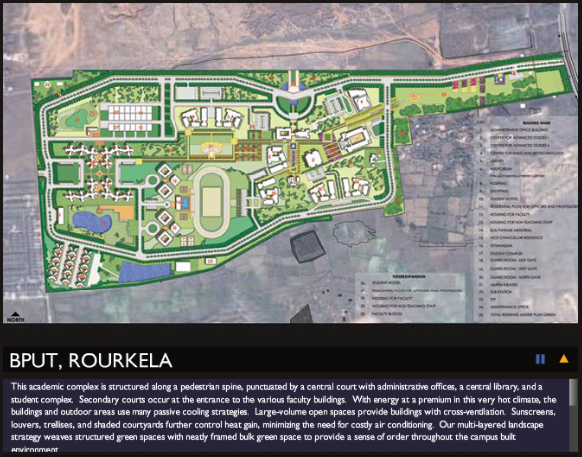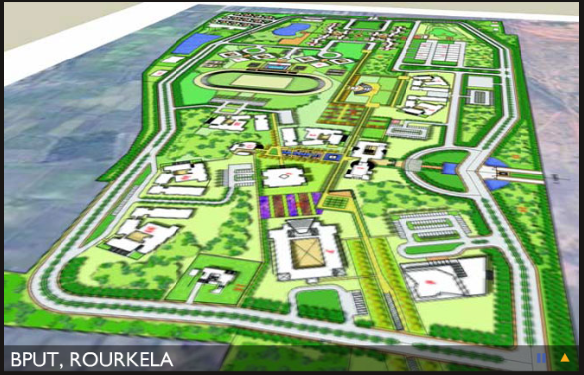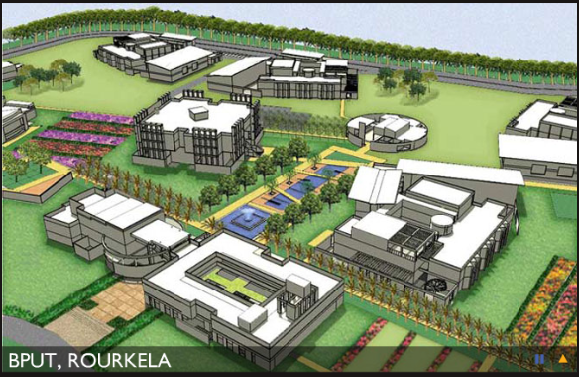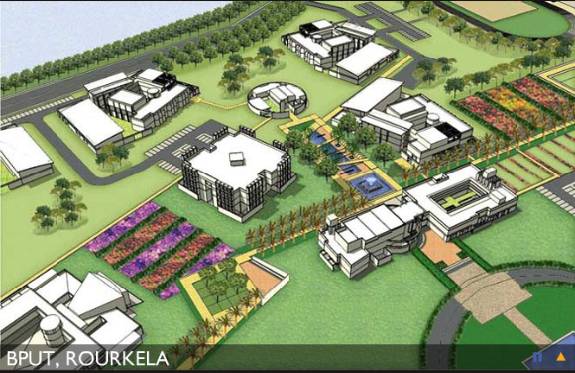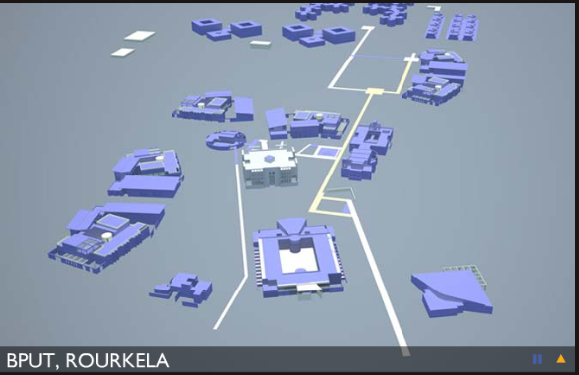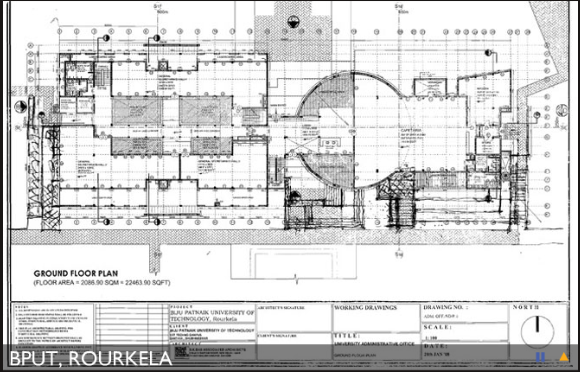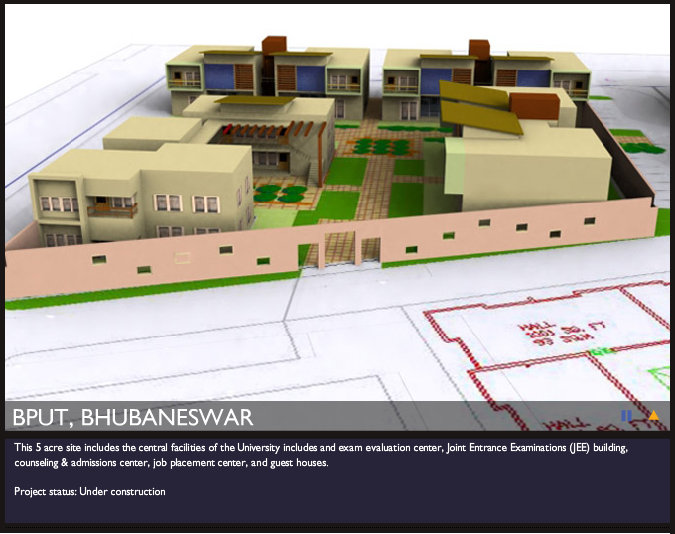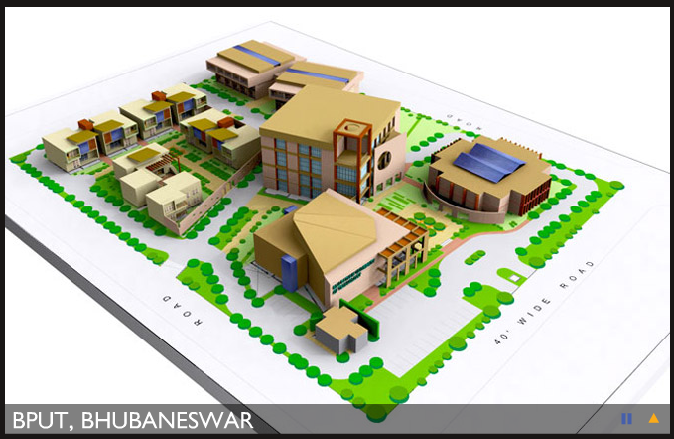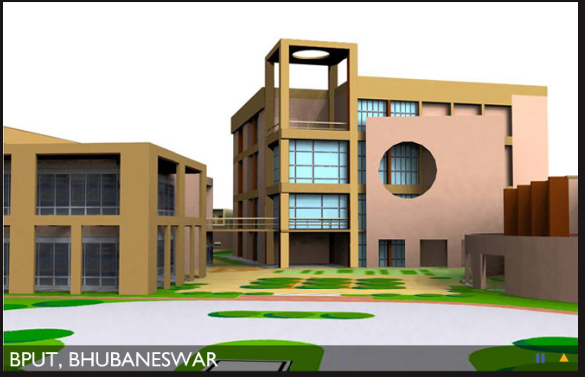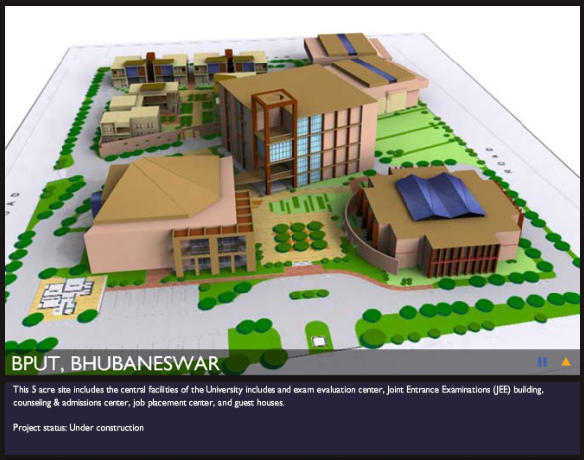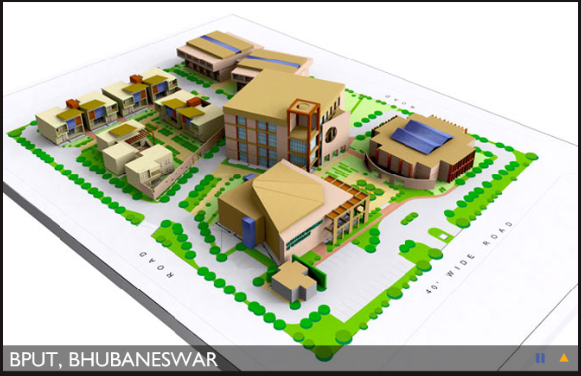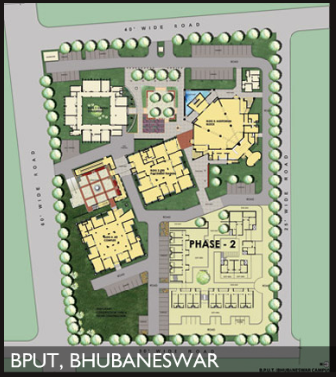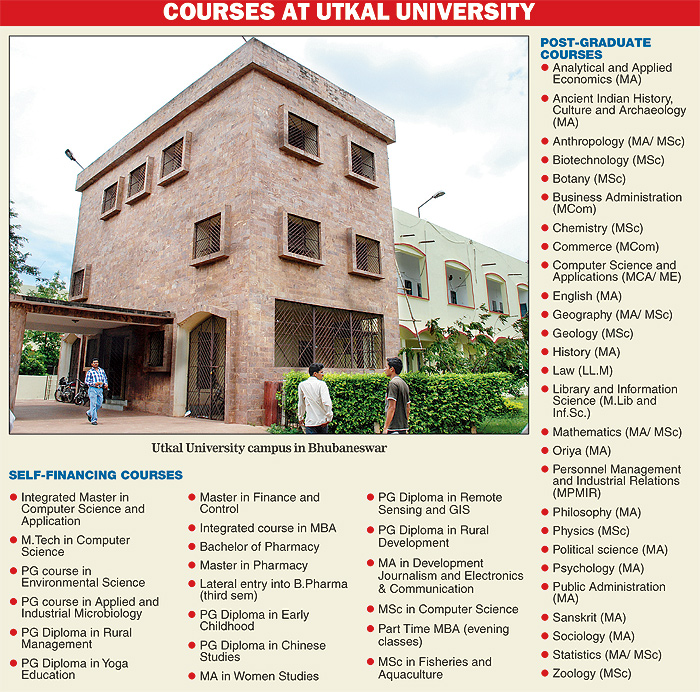Update on July 21, 2011: Following is from Samaja.
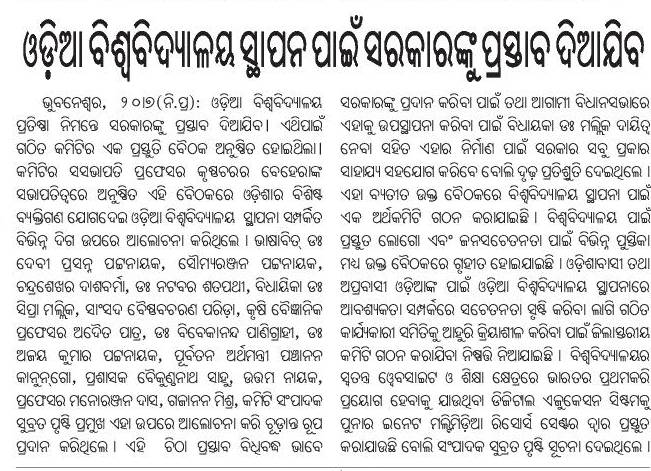
Following is from a report in Times of India.
With an aim to develop Oriya language and to promote the literature, traditions, culture and folklore of the state, a group of Oriya language lovers have come forward to set up an Oriya University. The university has been planned on the lines of Tamil university Tanjavur, in Tamilnadu; Telugu University, Hyderabad, in Andhra Pradesh; and Kannada Universty, Hampi, in Karnataka.
"Even though Orissa is the only state to be formed on the basis of language, unfortunately Oriya language has not got its due. English still remains the primary language used for all government and judicial communiqu’. Despite its richness and antiquity, the growth and development of the language has been restricted over the years," said Gajanan Mishra, founder member of Odia Viswavidyalaya Trust, a lawyer from Titilagarh.
Though the initiative to set up an Oriya University was started a couple of years ago, first concrete steps in this regard were only taken in 2010 with the formation of the trust. "So far we have not faced any challenge or obstacle in the formation of the university. Rather the journey has been quite encouraging and supportive. We are hopeful the dream would be realised soon," Mishra said.
With over 250 active members, including students, academicians, litterateurs, lawyers and politicians, the trust has launched a massive awareness campaign across the state to solicit public support for the university.
"We are planning to table the draft of Odia University bill in the coming assembly session. The proposed university will be set up in a public-private partnership mode in association with the state government," said member of draft committee, Panchanan Kanungo.
In a preparatory meeting here on Sunday, executive members of the Odia Biswabidyalay Sthapana Committee decided to solicit more members from across the state. "The finance committee and draft committee of the university were selected in the meeting. Now we would expedite the work to establish the university at a faster pace," said secretary of the committee, Chitta Ranjan Behera.
A research scholar of Oriya language in Utkal University and founder member of the university trust, Subrat Prusty, said, "The medium of education in the university will be Odia. Emphasis will be given on the development and growth of the Odia language, including phonetics, phonology, morphology, morphophonemics, syntax, semantics, semiotics, preparing pedagogical grammar, comparative vocabulary, lexicon, and language learning."
The university will also deal with history and economics of language use, creation of dialects, sociology dealing with various aspects of sociolinguistics and psychology, dealing with cognitive aspects of Odia. Sciences including acoustic phonetics and scientific discourses will also be taught in the university, founder members said. Separate departments for translation, folklore and culture, manuscriptology, and faculty of Odia development and tribal studies are proposed in the draft bill.
July 11th, 2011
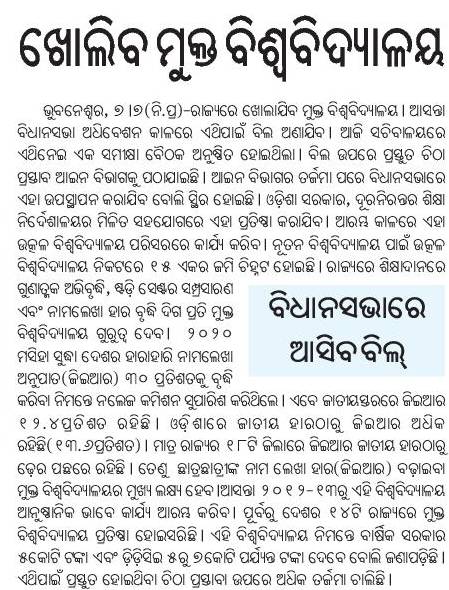
July 9th, 2011
The web page of Orissa Model Tribal Education Society (OMTES) is http://www.omtes.org. Following are excerpts from its "Background" page.
The Orissa Model Tribal Education Society (OMTES), a registered Society supported by the ST & SC Development Department, aims to make positive interventions in the field of tribal education. Since its inception in March 2000, it has been instrumental in setting up 11 Ekalabya Model Residential Schools in different parts of the State with assistance from Government of India. Besides that it also manages 19 Educational Complexes set up for providing education to ST Girls belonging to Primitive Tribal Groups. OMTES continues in its endeavour to serve the tribal population of the State by ensuring them to avail best opportunities in education at par with the non tribal population.
Following are some Q & A from its FAQ page.
How the schools are managed at the district level?
A school level management committee headed by the Collector of the respective districts, members including two educationist of the area looks after the overall development of the schools. Here the collector is the chairman and concerned Principal of ERMS is the Member Secretary.
I am a Tribal, what is the benefit the society has for me?
You benefit, when your child qualifies entrance of the school and receives free qualitative education. The society provides for improving the quality of tribal by promoting educational schemes for tribal community and improves the quality of life of tribal by Ashram Schools, Hostels for Tribal Boys Educational complexes, Post- Matric Scholarships and Book Bank Schemes, etc.
Whom do I contact for more information?
For information you are requested to contact ST & SC Development, Govt. of Orissa.
The 11 schools are listed in the page http://www.omtes.org/Yearwise_establishment_EMRS.html. They are in the districts of Koraput, Mayurbhanj, Sundergarh (3), Rayagada, Koenjhar, Gajapati, Kandhamal, Nabarangpur, and Jajpur.
The 19 educational complexes are listed in the page http://www.omtes.org/Yearwise_establishment.html. They are in the districts of Keonjhar (3), Rayagada (2), Nuapara, Mayurbhanj (2), Deogarh, Angul, Kalahandi, Ganjam, Gajapati (3), Malkangiri (2), Sundergarh and Kandhamala. Each of these complexes have a capacity of 250 making a total capacity of 4750.
In contrast, as of today, KISS has a student body of 15,083, which includes 3553 students pursuing +3. KISS had a student body of 1500 in 2005. I am sure the performance of the students is better at KISS than of the students at the OMTES schools and educational complexes.
So the Odisha government should just give land, seed money and grants to KISS and let them establish and manage much larger facilities in the districts with significant tribal students.
In http://www.kiss.ac.in/admission.html it is mentioned that every year KISS gets 30,000 to 40,000 applications per year for admission and admits between 2000-3000 of them. The government should fund KISS so that if not all who apply are admitted at least half of them are admitted.
It is a pity that other states have taken note of KISS and are inviting KISS to open replicas in their states while Odisha does not seem to be taking similar steps. Following is an excerpt from a report in Pioneer on other states approaching KISS for replicas.
A branch of the Kalinga Institute of Social Sciences (KISS) has been set up in Bastar, a tribal dominated and Maoist infested region of Chhattisgarh with assistance from the National Mineral Development Corporation (NMDC).
An MoU to this effect was signed between the KIIT and the KISS founder Dr Achyuta Samanta and NMDC director GB Joshi in the presence of the NMDC chairman cum managing director Rana Som at the the latter’s Corporate Office in Hyderabad on June 24.
As per the agreement, the NMDC has provided 30 acres of land along with all financial assistance to the KISS in order to set up its replica in Kankar region of north Bastar district in Chhattisgarh. In the first phase, 1000 tribal boys and girls will be admitted in this school. However, a total of 4,000 students from five districts in and around Bastar will get the opportunity of quality education here in course of time.
After Bastar, the Governments of Jharkhand, Madhya Pradesh and Delhi are keen to set up such model schools bearing all financial implications. They have requested Dr Samanta accordingly.
The page http://www.kiss.ac.in/fmngt.html explains how KISS is funded. The total amount there adds up to 18 crores. If 10 such KISS replicas are established in 10 tribal districts of Odisha at an additional cost of 200 crores/year, that will be the best use of such money for Odisha.
July 8th, 2011
Following is an excerpt from Shilpi Sampad’s report in Telegraph.
A university official said the sale of forms have soared this time as compared to previous years. Around 6,100 forms have already been sold at the two counters as against 7,000 last year. “We are expecting 2,000 more forms to come in. There has been an increase in sale of forms probably because more students are now opting for traditional and regular subjects,” the official said …
Following is an excerpt from a report in Times of India.
While there is just one applicant for statistics, which has 16 seats, there are very few aspirants for anthropology, food technology, bioinformatics electronics and home science.
Tripathy said there are very few colleges offering statistics at the graduation level. Hence, very few students want to pursue post-graduation in statistics. On the other hand, there are 66 applicants for 16 seats in MA or MSc mathematics.
The home science department this year has just four applicants for 16 seats. "This may be because the course had a new nomenclature this year. It was earlier called MA/MSc in home science. From this year, the varsity has changed it to MA/MSc home science (nutrition and human development) ," Tripathy said.
The varsity has got a record 250 applications for MSc Physics which has 24 seats. Some of these students will be given option to take admission in MSc electronics which has received around 10 applications for 20 seats.
The Sambalpur University Institute of Information Technology, which offers the bioinformatics and electronic courses, said students who have applied for MSc life sciences but failed to secure a seat will get a chance to take admission in MSc bioinformatics.
… Besides physics, departments of chemistry, English, sociology and political science also have received huge number of applications.
The varsity has got over 230 applications for 24 chemistry seats and 88 applications for 24 English seats. The varsity has got around 1800 applications this year for various PG courses compared to 1500 applications last session, varsity officials said.
June 29th, 2011
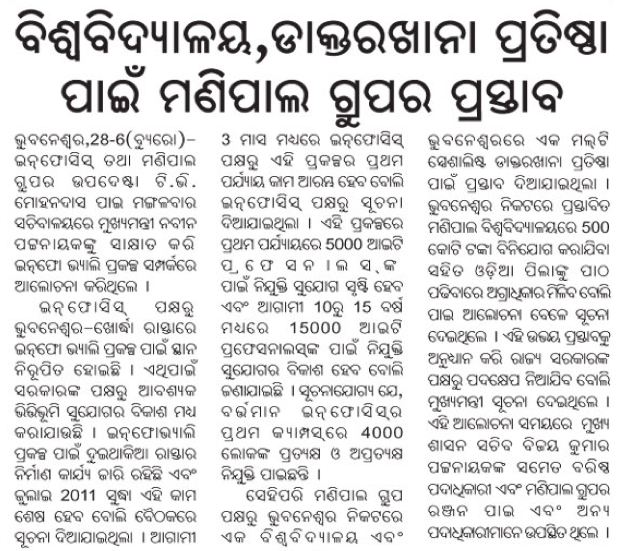
More information on Manipal can be found in http://en.wikipedia.org/wiki/Manipal and its official website at http://www.manipal.edu.
Among its various constituents the following have been ranked:
Some of its other salient features are (from its factsheet):
- Manipal has several international campuses including the Sikkim Manipal University. The other international campuses are in Malaysia, Nepal and Dubai.
- Over 300 courses offered across 14 professional streams in over 25 colleges
- India’s largest Foreign exchange earner in its category
- Over 1,20,000 students and 3,00,000 alumni from over 52 countries
- Established in 1953, Manipal University is the first educational Institution in private sector to become a deemed University; Over 20,000 students from over 52 countries
- Over 3000 practicing doctors in the US and every 4th doctor in Malaysia is an alumnus of
Manipal.
- SMU has two constituent institutes – Sikkim Manipal Institute of Medical Sciences (SMIMS) and Sikkim Manipal Institute of Technology (SMIT)
- Dubai Campus: Set up in September 2000 and is currently located in Dubai International Academic City; Has over 1400 students from over 20 countries, enrolled in its various specialized programs
Finally, Manipal is in the process of establishing Manipal International University in Jaipur. They are taking students from this year. Following is an excerpt from that page.
On invitation by Govt. of Rajasthan to Manipal Group, to start a multi-disciplinary Private University, Manipal International University, Jaipur, in the state comprising of courses in different disciplines like Engineering, Medical, Hospitality, Allied Health, Management, Communication, Jewellery Management etc.
… Allotment of 100 Acres of land at Dehmi Kalan Village near Jaipur in for the proposed campus.
June 29th, 2011
Earlier we mentioned the dynamism of the current Sambalpur University VC and some of the steps he has taken. This includes the establishment of SU-IIT (with B.Tech, M.Tech, MSc and MCA programs) and GOI funded Center for Food Science & Technology (offering an M.Tech). In addition to those, I got information regarding several additional new programs and centers. Those are:
- A 5-year integrated BBA+LLB program starting this July.
- Establishment of a School of Performing Arts with special thrust on Folk dance (Sambalpuri, Chhau, etc).
- A program on Insurance and Risk Management
I also came across the following ad in today’s paper.
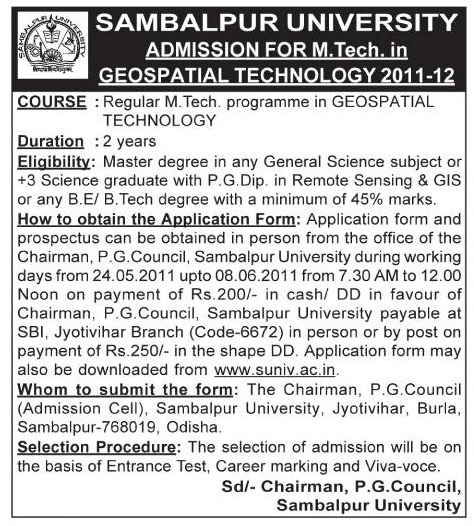
In general, Prof. Arun Pujari, the current VC of Sambalpur University (on-lien from University of Hyderabad, where he has been a Professor in Computer Science as well as a Dean), has made significant contributions to Sambalpur University in his short tenure; much more than any Odisha VC I know of in recent years. Unfortunately his 3-yr tenure is coming to an end in November and already this year none of the 3 VCs (Utkal U, Fakir Mohan U, and NOU) were reappointed.
I hope the Odisha Governor makes an exception and reappoints Prof. Pujari for another 3 year term so that he can stablize the various programs and centers that he initiated and established.
If that happens there is a high chance that the best two universities of Odisha will be in Sambalpur: VSSUT and Sambalpur University.
May 26th, 2011
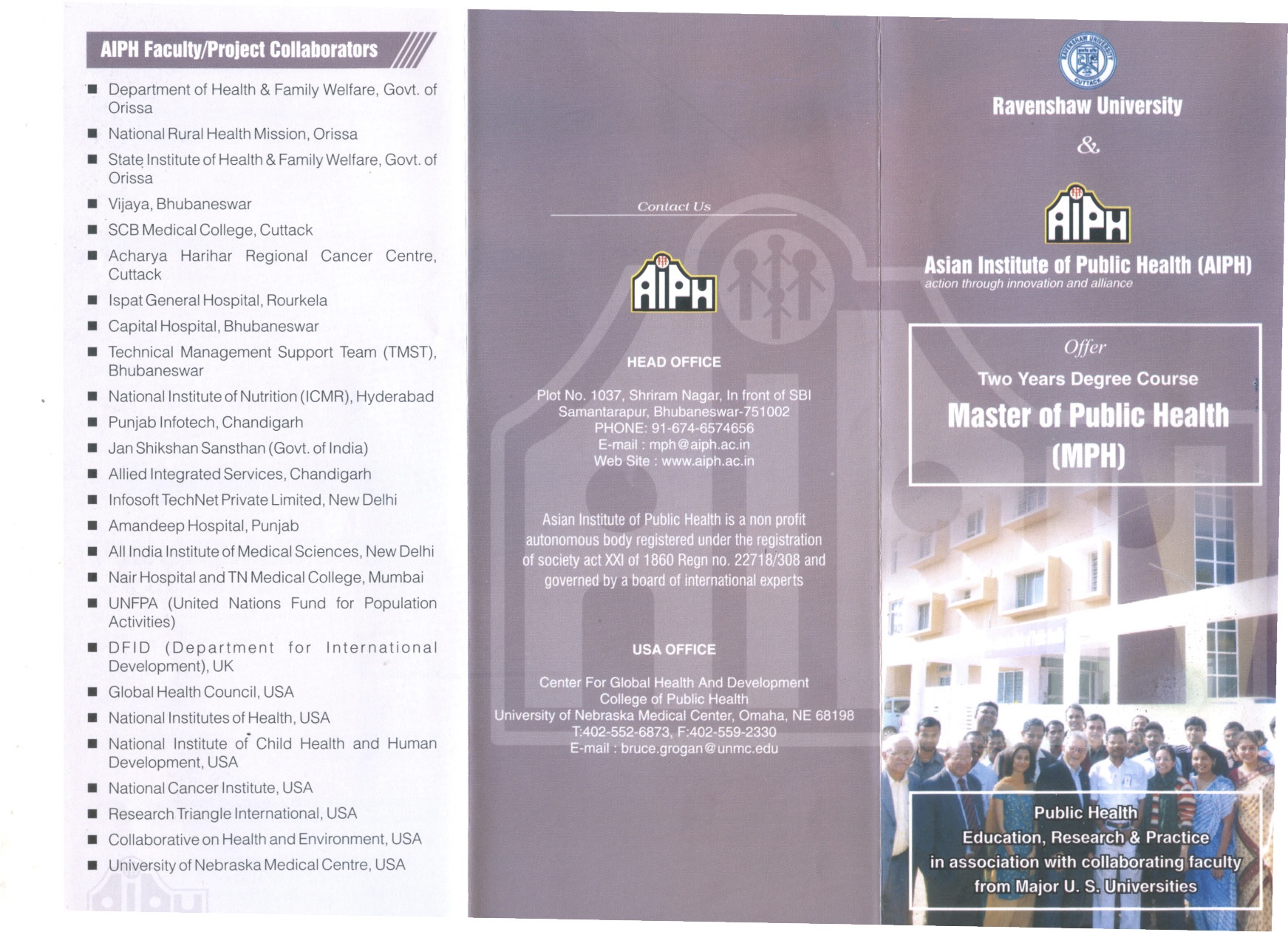
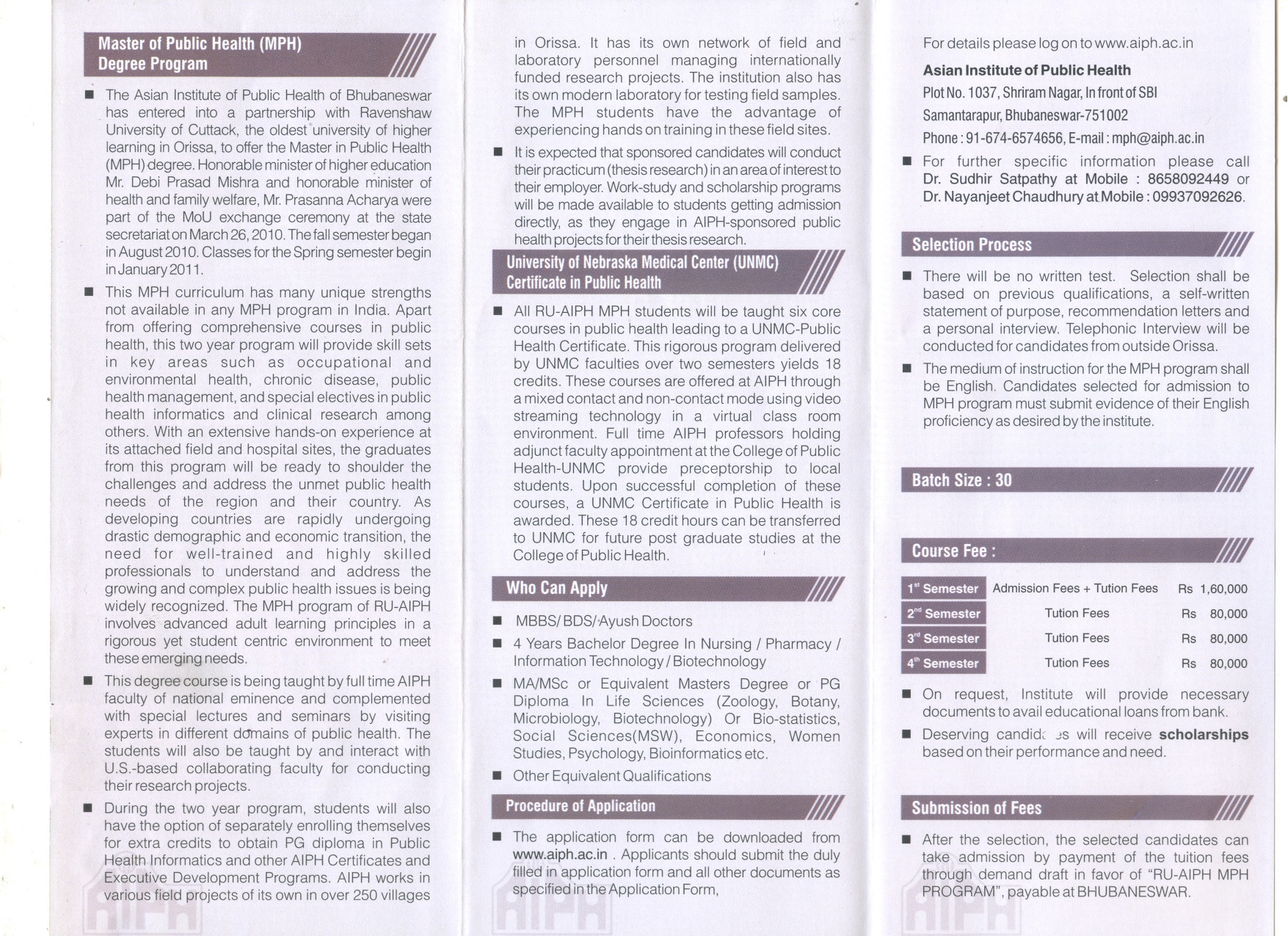
May 22nd, 2011
Following is an excerpt from a report in Pagalguy.com.
… Great Lakes Institute of Management, Chennai on May 6 announced its own plans to expand operations to Gurgaon and Orissa in addition to its earlier takeover of Mumbai Business School.
… The Great Lakes-Educomp partnership will also build a business education-oriented university in Orissa, tentatively named ‘University of Corporate Excellence’. Once the university kicks off, Great Lakes would have had spread its presence in all four corners of the country, says Prof Balachandran. While Great Lakes – Chennai has built a strength around marketing, IEMR will focus on the energy sector and MBS on emerging markets.
Educomp’s Rs 150 crore investment is part cash and part infrastructure and technology, such as its e-learning platform which will be powered using Great Lakes content to offer distance learning.
May 17th, 2011
It now has its own website at http://suiit.ac.in/. Following is the ad that appeared in various newspapers.
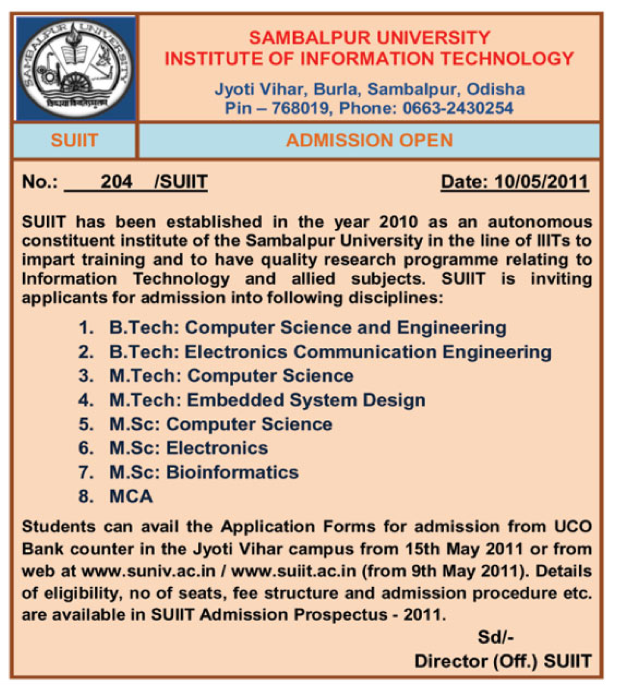
Following is a screen copy of the web page of SUIIT.
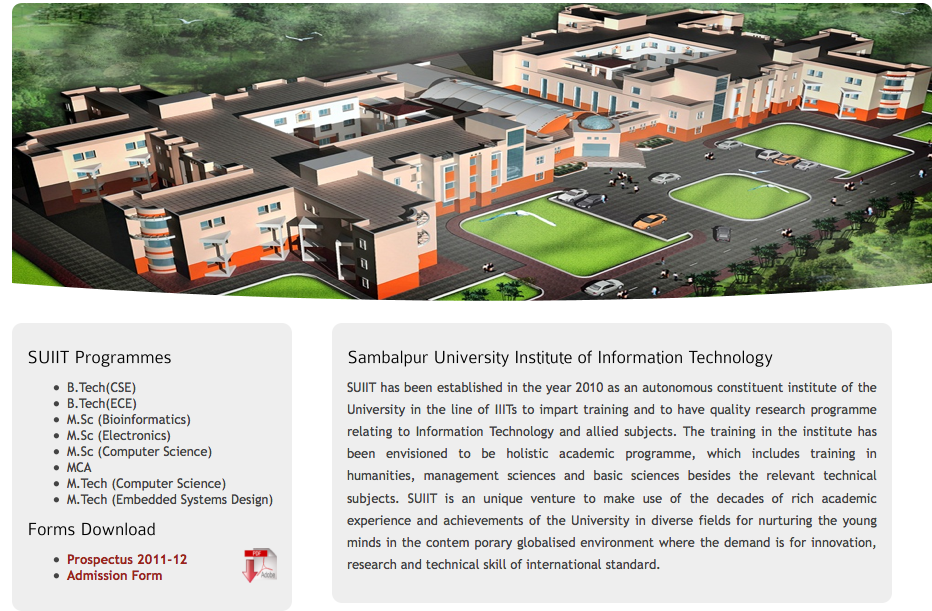
With the new B.Tech programs, Sambalpur University will become the first general university of Odisha to offer such a program. Kudos to its VC for his vision and this unique achievement.
May 13th, 2011
The interview is at http://timesofindia.indiatimes.com/city/bhubaneswar/Student-unrest-wont-occur-in-my-tenure-Prof-Sahu/articleshow/8171439.cms. Following are some excerpts.
Q-The University is often in the news for the wrong reasons like mismanagement, student unrest, etc. What is your plan to bring Utkal University back on track?
A-I want Utkal University to be a centre of excellence and lead centre in research and consultancy works both at the national and international-levels. I studied here. I also taught here. I have a vision. I will try my best in making positive contribution towards achieving the goal during my tenure.
Q-How?
A-Actually we have to develop inter-disciplinary teaching and research. There is a need to restructure the post-graduate programme. One person cannot do this. Hence, I stress upon team work. In other words, different departments ought to sit together, discuss what is being taught to students and their relevance and, if required, redesign them. The changing scenario also warrants the university to reorient its focus, to be collaborative with industries which will eventually benefit the students and the institution as well.
Q-Any specific plan?
A-Professional and job-oriented courses are the need of the time. I have plans to open such programmes like fashion technology, geo-informatics and environment science. I will discuss with my colleagues and explore possibilities of opening other relevant courses.
Q-But Utkal University already has a number of such courses. Don’t you think before going for new ones those already there need to be reviewed to find out the net benefits they are giving to the students?
A-Sure, I agree the course module has to be so designed that students taking admission must not feel they are wasting their time and that they become truly employable. We have a lot of self-financing courses. I will review the course curriculum through experts and go for changes wherever necessary.
Q-Any move for foreign tie-up?
A-That is very much there in my mind. I will explore the possibility of Utkal University undertaking research or launching new course programmes in collaboration with foreign universities. The university has to have linkages with industries. This will go a long way in helping students. I will try to set up some school of studies. For example, management, economics, commerce and personnel management and industrial relations (PMIR) could jointly become a school of studies for the purpose of research and other academic activities.
… I am also a product of the IIM-Ahmedabad. I know management. Utkal University requires a professional and qualified vice-chancellor. I fit the bill.
…
Q-A good library has always been the most attractive place for students. Do you believe the Parija Library meets expectations?
A-A library is the mirror of any educational institution. I have taken it as my priority to improve the quality of the library in the campus. I will try to equip it with latest technology so that students could use it round-the-clock. I have already had a word with the chief librarian. I have sought for a wish list, to be submitted to me soon. Accordingly, we will proceed.
Q-There are also allegations of financial irregularities against the university. What are you going to do with that?
A-I am a professor of finance. I will streamline it.
Q-What about modernizing the administrative apparatus?
A-That is going to happen. There will be an academic calendar, to be followed religiously. The examination system will be completely computerized. On the whole, there will be greater use of information technology in the functioning of the university. Times have changed. We have to tune ourselves so as not to fall behind.
Q-Just buildings or computers do not foster the right kind of academic atmosphere in a university. That is why many educational institutions in India and abroad give stress on creating greenery in their campuses. Utkal University campus pathetically looks desolate.
A-Yes, that is a point no one should forget. I am taking steps. There will be a change.
I will add my thoughts on this soon. Please add your thoughts in the comments section. Please be polite.
My thoughts:
- I disagree with the statement that "Professional and job-oriented courses are the need of the time". It was a few years back. Now, with so many new universities and colleges opening up, there is plenty of job opportunity in academic settings.
- Thus, Utkal University should focus on improving the quality of its programs, its faculty, its research and its graduates and focus on research and producing top-notch Ph.Ds who go into academia all over India.
- With the easy availability of data and information on publications, citations and various benchmarks based on that, many future decisions at MHRD, UGC, DST, etc. will be based on those data. If Utkal University does not focus on those benchmarks it will lose out and as a result Odisha will lose out.
- It should aim to have the best group in some small number of fields, say 3-4. In other words, in those fields, Utkal University should be the best in India and among the top in the world.
May 6th, 2011
The newsletter is at http://www.centraluniversityorissa.ac.in/Downloads/Newsletter_Feb.%202011.pdf.
Page 9: From the Vice-Chancellor’s statement:
From the forthcoming academic session the University proposes to introduce five new subjects under New Schools …
As for the progress of our physical infrastructure of the main campus, the construction of the Boundary Wall is almost through and the construction of buildings in the first phase, the Girls’ Hostel, the Boys’ Hostel, the Guest House and the Academic Block I are likely to start towards the end of March.
… As a Founding Vice-Chancellor my vision of this composite University has two well-defined thrust areas in terms of priorities: One is healthcare and subsequently the introduction / dissemination of medical education and the other is related to the development and welfare of the tribal community.
Page 12: Development of Campus (progress of the Boundary Wall)
The main campus of our University is coming up at Sunabeda. The construction of boundary wall undertaken by CPWD is in progress. Out of actual 9.3 kms of boundary wall about 8.6 kms work is completed. The pillar excavation, raising columns on rocky terrains of the boundary is almost over. The brickwork and plastering of the Boundary Wall is going on in full swing.
The master plan has also been approved by the University Building Committee. Recently the Chief Engineer of CPWD has visited our main campus in Koraput and inspected the progress of construction work.
Page 24: The List of forthcoming Centres and Schools of the Central University of Orissa duly approved by the Academic Council and the Executive Council
The Academic Council and the Executive Council of CUO have approved the establishment of the following new Schools and Centres:
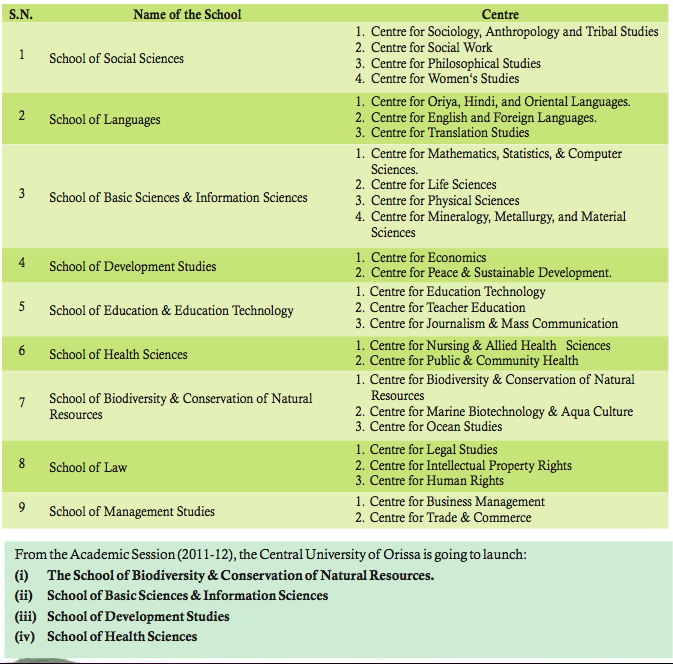
Page 31: Centre for Tribal Welfare and Community Development
Extreme poverty has its own typical features and adverse impacts on any society. Migration in search of survival for livelihoods is gradually becoming a common phenomenon in the KBK region as well as in the other parts of the country. For the survival of local people, the traditional skill based occupations are gradually becoming uneconomic options. On the other hand the same traditional skills have a flourishing market value in neighbouring states. This creates situations for mass migration, often with the family, in search of a livelihood even under stressful conditions. In the recent trend of economic development, the traditional skill based occupations have also became largely resource dependent. With the depletion of natural resources, the traditional occupations of tribes are fading away, though these are also the outcome of the occupational mobility.
The Koraput District comes under the tribal sub-plan area and PESA. As per the provision, PESA promises devolution of power to Panchayats completing the tribal self-rule. While larger accountability for the utilizing the provisions under the Act is vested in the Panchayats, due to poor understanding of the Act by the Panchayatiraj functionaries the Act seems to have lost its legal tooth in this area. This calls for wider accountability of government and civil society bodies to build the capacity of the PRIs thereby enabling them to utilize the power and authority vested in them for the development of their area and the communities. The customary rules existing even today provide a framework to compare the provisions of PESA and a suitable blending of two can contribute towards good governance to spearhead developmental process.
According to the report of the Committee on the Constitution of Separate Development Board in Orissa, 96% of Community Development Blocks in KBK districts are either ‘very backward’ or ‘backward’. According to the UNDP Human Development Report 2004, Malkangiri, Kandhamal, Gajapati, Koraput, Nabarangpur are the bottom five districts in terms of HDI values, three of which are in KBK region.
Considering the above issues, the Centre for Tribal Welfare and Community Development (CTWCD) has been established as University’s first initiative of Corporate Social Responsibilities to foster the needs and take up the issues of the tribals of KBK region as well as other tribal groups of India.
The Centre for Tribal Welfare and Community Development at Central University of Orissa is functional since 5th June,2010. A batch of tribal youth has already received training on mushrooms cultivation. New initiatives are under progress and it is hoped that various trade identified by the Centre will benefit the tribes.
Page 47: Progress of new Campus
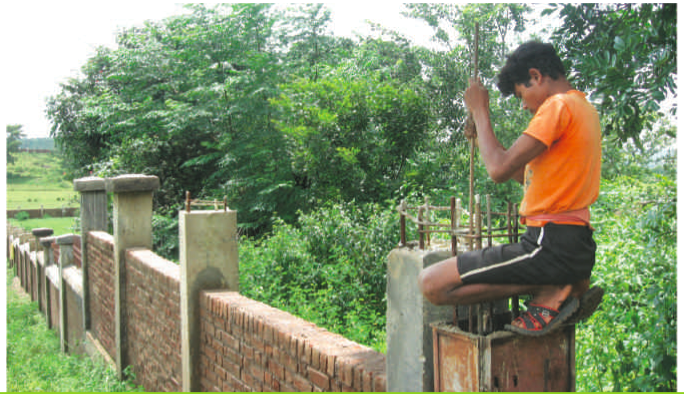
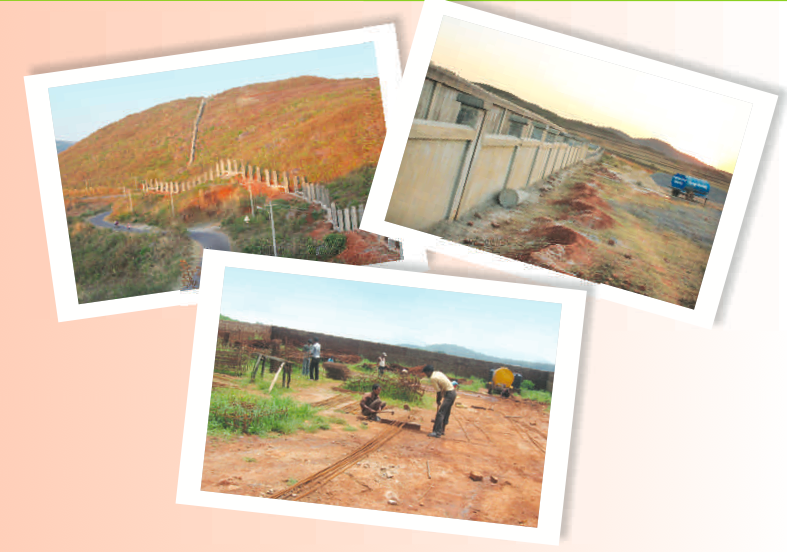
April 27th, 2011
The following is compiled from various pages of http://www.utkal-university.org/.
| Departments |
Faculty |
Program offerings and seats |
| Analytical and Applied Economics. |
Professors:
1) Dr. (Mrs.) P. Mishra – Mathematical Economics, Regional Economics & Environmental Economics
2) Dr. K. B. Das – Regional Economics, Mathematical Economics
3) Dr. Bhabes Sen – Quantitative Techniques, Econometrics, Mathematical Economics, Statistics
Reader
1) Dr. (Mrs.)Mitali Chinara – Mathematical Economics & Econometrics
Lecturer
1) Mrs. Aparajita Biswal – Econometrics, Mathematical Economics
2)Shri Alok Ranjan Behera – Financial Institution & Markets
3) Shri Amarendra Das – Environmental Economics, Natural Resource Management
|
M.A. –88, M.Phil – 10 |
| Ancient Indian History, Culture and Archaeology |
Professors
1) Dr. Sadasiba Pradhan : Ancient Indian History, Art History & Archaeology
Reader
Dr. Sanjay Acharya – Ancient Indian History, Art and Archaeology.
Lecturer
1. Mr. Anam Behera – Ancient Indian History, Culture & Archaeology.
2. Dr. Sushanta Ku. Patra –
|
M.A. –32, M.Phil –10 |
| Anthropology |
Professors
1. Dr. P. K. Nayak – Social Anthropology, Development Anthropology
2. Dr. P. K. Das – Physical Anthropology & Human Genetics
3. Dr. J. Dash – Social Anthropology
4. Dr. K. K. Basa(On Lien) – Pre-historic Archaeology
Readers
1. Dr. (Mrs.) R. Mohanty – Population Studies, Biological Anthropology
2. Dr. (Mrs.) S. Acharya – Social Anthropology.
3. Dr. (Mrs.) U. Aparajita – Social Anthropology & Development Anthropology.
Lecturer
1. Mr.D. Sahoo – Pre-historic Archaeology.
|
MA/MSc- 32, MPhil –10 |
| Biotechnology |
Reader
Dr. Jagneshwar Dandapat : Cell & Molecular Biology, Immunology
|
M.Sc – 10 |
| Botany |
Professors
1. Dr. H. K. Patra – Environmental Science(Environmental Physiology)
2. Dr. P. K. Chand – Cytogenetics, Genetic Engineering.
3. Dr. S. P. Adhikari (on lien) – Physiology, Biochemistry & Ecology of Cyanobacteria.
Readers
1. Dr. (Mrs.) S. Sahoo – Plant Physiology and Biochemistry
2. Dr. P. K. Mohapatra (on lien)– Ecotoxicology
3. Dr. K.B. Satapathy –
Lecturer
1. Dr. Chinmay Pradhan
|
M.Sc. –32 M.Phil –10
SF – M.Env Sc. – 16
SF – M. Applied & Ind. Microbiology – 16
|
Business Administration
|
Professors
1. Dr. P. K. Sahoo,(Head of the Department) – Financial Management
2. Dr. P. K. Mohanty(On-Lien) –Human Resource Management
3. Dr. N. C. Kar – Financial Management
4. Dr. B. K. Mangaraj(On-Lien) – Information Resource Management
5. Dr. J. K. Panda – Financial Management
Readers
1. Er. P. C. Ratha – Operations Management
2. Dr. B. B. Mishra – Marketing Management & Organisational Behaviour
Sr. Lecturer
Dr. Muna Kalyani – Human Resource Management & Organisational Behaviour
Lecturers
Dr. B. R. Jena(on leave) – Business Economics
Dr. Dasarathi Sahu – Information Technology
|
SF – 5yr Integrated MBA – 60
SF – 3yr part-time MBA – 40
|
| Center for Agri-Management |
Professor
Prof. (Dr) Benudhar Bhuyan, Dr P K Sahoo, Dr N C Kar, Dr P K Mohanty, Dr B K Mangaraj, Dr J K Panda
Reader
Er P C Rath, Dr B B Mishra
Sr. Lecturer
Dr M Kalyani, Dr B Jena
Lecturer
Mr Sukant Kumar Samal, Mr Manoj Bal, Ms Anuradha Mishra, Dr D Sahu
|
MBA in Agribusiness |
| Chemistry |
Professors
1. Dr. S. Jena – Organic Chemistry
2. Dr. P. Mohanty – Inorganic Chemistry
3. Dr. S. P. Rout – Analytical Chemistry
4. Dr. G. C. Pradhan – Inorganic Chemistry
5. Dr. P. K. Sahoo – Organic / Polymer Chemistry
Readers
1. Dr S.K. Badmali – Physical Chemistry
Senior Lecturer
1. Dr. (Mrs.) Jasoda Kumari Behera– Inorganic Chemistry
Lecturer
1. Mrs. B. Jena – Physical Chemistry
|
M.Sc.-28, M.Phil-10 |
| Commerce |
Professors
Dr. S. Moharana – Business Finance and Small Industries Development.
Dr. R. K. Bal – Accounting, Corporate Financial Reporting and Banking
Dr. J. K. Parida – Tax Law and Practice and Computer, Business Environment
Readers
Dr. P. K. Pradhan – General Management and Organic Behaviour
Dr. P. K. Hota – Operation Research and Business Statistics and Security Analysis & Portfolio Management
Dr. M. Sahu
– Marketing, Financial Services, Merchant Banking
Dr. K.B. Das – Managerial Economics, Insurance
Lecturer
Dr. A. K. Swain – Accounting, Finance & Insurance
Dr. S.K. Digal – E-Commerce, International Finance and Financial Management and Entrepreneurship
Mr. R.K. Swain – Accounting
|
M.Com – 48 M.Phil – 10
SF – M. Finance & Control. – 30+10
|
| Computer Science and Applications |
Professors
1. Dr. A.K. Bisoi – Computer Graphics & Fractal Modeling, Software Engineering
2. Dr. (Mrs.) S. Mohanty – Image, Speech & Natural Language
Processing
Reader
Dr. S. K. Pradhan(on lien) – Parallel Processing, Neural Computing
SG. Lecturers
Mr. B. K. Ratha – Image Processing
Dr. P. K. Behera – Mobile Computing
Sr. Lecturer
Dr. B. N. B. Ray – IP Telephony
|
MCA – 30
ME in CSE with Sp. in Knowledge Eng.- 15
SF– 5 yr integrated MCA – 60
SF– 2 yr M.Tech in CS – 30
SF-2 yr M.Sc in Comp. Sc. – 30
The SF courses are jointly with Math and Stat. dept.
|
| English |
Professor
1. Dr. H. S. Mohapatra – Critical Theory, Fiction
2. Dr. J. K. Nayak – British Fiction Translation, Comparative Literature
Sr. Lecturer
1. Dr. D. Naik (On Lien) – Fiction, Literary Theory
2. Dr. A. J. Khan (On Lien) – Commonwealth Literature
|
MA – 40 M.Phil – 10 |
| Geography |
Professors
1. Dr. G. K. Panda – Geomorphology,Environmental Geography, Remote Sensing and G.I.S.
2. Dr. P. K. Kara – Applied Geography, Urban and Regional Planning, Population Geography.
Readers
1. Dr. K. M. Sethy – Urban and Regional Planning, Economic Geography, Remote Sensing and G.I.S.
2. Dr. K. C. Rath – Urban and Regional Planning, Remote Sensing and G.I.S., Social Research Method.
3. Dr. D. Panda – Environmental Geography, Geomorphology, Agriculture Geography, Medical Geography, Remote Sensing and G.I.S.
Lecturer
Dr. Ranjana Bajpai – Political Geography & Environmental Geography
|
MA/MSc.-24 M.Phil-10. RS & GIS-20
SF – PGDip in Remote Sensing & GIS – 20
|
| Geology |
Professors
1. Dr. H.K. Sahoo, – Hydro Geology, Economic Geology, Geo chemistry, Environmental Geology
2. Dr. P. Behera – Coal Geology, Hydro Geology, Sedimentology,Environmental Geology
3. Dr. (Mrs.) M. Das – Igneous Petrology, Hydro Geology, Ore Geology, Environmental Geology
4. Dr. P. P. Singh – Ore Geology, Structural Geology
5. Dr. R. N. Hota – Sedimentology, Geo-statistics, Hydro-Geology
Readers
3. Dr. D.S. Pattnaik – Coal Geology, Hydro Geology
4. Dr. B. K. Ratha – Economic Geology, Engineering Geology, Geo-chemistry, Environmental Geology
Lecturer
1. Dr. D. Beura – Economic Geology, Environmental Geology
|
M.Sc.-25, M.Phil-8 |
| History |
Professors
1. Dr. A.K. Pattnaik – International Affairs,
Foreign History, Modern Indian History, Historiography.
Readers
1. Dr. Amal Kumar Mishra – Modern Indian History, World History, Regional History.
2. Dr. Basanta Kumar Mallik – Medieval Indian History, World History Regional History, Historiography.
3. Dr. Jayanti Dora – Ancient History
|
M.A.-64, M.Phil-06 |
| Law |
Professors
1. Dr. Pradip Kumar Sarkar – Commercial Law
2. Dr. Prafulla Ch. Mishra – Family Law(Personal Law)
3. Dr. Prabir Kumar Pattnaik – Criminal Law, Commercial Law
Reader
1. Dr. M.S. Dash – Commercial Law
2. Sri Durgesh Chandra Mahapatra – Criminal Law and Commercial Law
|
LL.M – 25 |
| Library and Information Science |
Professor
1. Dr. Manoranjan Mohapatra : Classification Information Storage & Retrieval
Readers
1. Dr. (Mrs.) Puspanjali Jena – Foundation of Library & Information Science Research Methodology & Statistical Techniques, Internet & CD ROM Database Serchey.
2. Dr. K.C. Das – Digital Library, Information Technology & Networking
Lecturer
1. Sri Kunwar Singh – Management of Library & Information Centre, Library Automation and Software package.
|
M.Lib. & Inf.Sc. – 24 |
| Mathematics |
Professors
1. Dr. S. Padhy – Parallel Algorithm, Numerical Analysis and Fluid Dynamics, Computational Finance, Bio-informatics
2.Dr. B. K. Nayak – Theory of Relativity, Differential Geometry
3. Dr. J. Patel – Complex Analysis
Readers
1. Dr. (Mrs.) S. Dutta – Functional Analysis
2. Dr.(Mrs.) N. Das – Analysis
|
MA/MSc -64
M.Phil -10
SF– 5 yr integrated MCA – 60
SF– 2 yr M.Tech in CS – 30
SF-2 yr M.Sc in Comp. Sc. – 30
The SF courses are jointly with Comp. Sc. and Stat. depts. |
| Odia |
Professors
1. Dr. (Mrs.) Sanghamitra Mishra -Drama, Morden Literature
2. Dr. Bijaya Kumar Satapathy – Drama, Modern Literature
3. Dr. Sarat Chandra Rath – Religious Trends of Odia Literature, Mediaval Literature
4. Dr. Narayan Sahoo – Drama, Comparatvie Literature
5. Dr. Udayanath Sahoo –
Reader
1. Dr. Santosh Ku.Tripathy – Modern Literature, Comparative Literature, Poetics, Grammar & Language,
2. Dr. (Mrs.) Lipi Hembram – Religious Trends of OdiaLiterature, Drama
3. Dr. Bishnupriya Otta –
|
M.A.-64, M.Phil-10 |
| Personnel Management and Industrial Relations |
Professors
1. Dr. B.N. Mishra – Organisational Behaviour, Industrial Sociology & Social Security
2. Dr. S. K. Tripathy – Human Resource Management, Organisational Behaviour.
Readers
1. Dr. K. M. Sahoo – Human Resource Management .
2. Dr.(Mrs.) K. Mohanty – Man Power Planning
Lecturer
Ms. S. Murmu – Industrial Relations
|
MPMIR-32 M.Phil-8 |
| Pharmaceutical Sciences |
|
SF – B. Pharm (4 yrs) – 45 (Lateral entry allowed in 3rd semester) |
| Philosophy |
Professors
1. Dr. A. K. Mohanty – Philosophy of Language (Western and Indian), Analytical Philosophy, Political Philosophy, Philosophy of Value Philosophy of Religion, Indian Philosophy, Philosophy of Value, Analytical Philosophy
2. Dr. Sarat Ch. Panigrahi – Indian Philosophy, Analytical Philosophy, Philosophy of Mind, Political Philosophy. Philosophy of Religion, Indian Philosophy, Analytical Philosophy.
3. Dr. Ramesh Chandra Das – Logic, Philosophy of Value, Analytical Philosophy, Philosophy of Mind
Lecturer
Mr. S. Jally – Adaita Bedanta
Dr. Alakananda Parida
|
M.A.-64, M.Phil-10 |
| Physics |
Professors
1. Dr. N. C. Mishra – Electronics & Condensed Matter Physics
2. Dr. D. K. Basa – Solid State Electronic Materials and Devices
3. Dr. K. Maharana – Particle Physics, Gravitation & Cosmology
4. Dr. (Mrs.) S. Mahapatra – Particle Physics, Gravitation & Cosmology
Lecturer
Sri P.K. Samal – Cosmology
|
M.Sc.-30, M.Phil-10 |
| Political Science |
Professors
1. Dr. B. Satapathy – International Politics, Political Thought, Modern Political Analysis, Research Methodology
2. Dr. N. Gaan – International Politics
Lecturer(S.G)
Dr.(Smt.) Smita Nayak – State Politics in India, Political Process in Orissa, Public Administration.
Lecturer
1. Dr. A.K. Mohapatra – International Relations, Indian Govt. & Politics,
Comparative Politics
2. Dr.(Mrs.) S. Mallik – International Politics, Political Theory
|
M.A.-64, M.Phil-10
SF – PGDip in Chinese studies – 16
SF – MA in Women’s studies – 20
SF – M in Dev. Journalism & Elect. Comm. – 20
|
| Psychology |
Professors
1. Dr. P. K. Mishra – Organisational Industrial & Social Psychology.
2. Dr. S. K. Patra – Comparative & Physiological Psychology
3. Dr. N. C. Pati – Comparative & Educational Psychology
Readers
1. Dr. P. K. Ratha – Psychometric Assessment, Social and Personality.
2. Dr. (Mrs.) N. Patanaik – Educational & Counseling Psychology
Sr. Lecturer
Mrs. N. Das – Educational & Developmental Psychology
|
M.A.-48, M.Phil-16
SF – PGDip in Early Childhood Ed – 16
|
| Public Administration |
Professor
Dr. (Mrs.) B. Mohanty : Local Administration & Development Administration
|
M.A.-32, M.Phil-8 |
| Sanskrit |
Professors
1. Dr. G. K. Dash – Classical Literature, Vedic, Epic & Puranic Literature.
2. Dr. P. K. Mishra – Poetics. Literary Criticism & Vedic Studies
3. Dr. R. N. Panda – Classical Literature & Sanskrit Literature of Orissa
4. Dr. R. M. Dash – Grammar & Linguistics
Readers
1.Dr. (Mrs.) P. M. Rath (On Lien) – Vedic and Classical Sanskrit Literature.
Lecturer (S.G.)
Dr. S. C. Dash – Indian Philosophy
|
M.A.-64, M.Phil-10
SF – PG Dip. Yoga Education – 16
|
| Sociology |
Professors
1. Dr. (Mrs.) Rita Ray – Indian Social System, Gender Studies
2. Dr. Anup Kumar Dash – Studies in Voluntary Sector
3. Dr. D.N. Jena – Rural Development
4. Dr. B.G. Baboo(On leave) – Studies in Rehabilitation
Reader
Dr. M.G. Bage – Tribal Sociology
Lecturers (Selection Grade)
1. Mr. B.K. Behera (On lien) – Medical Sociology
Sr. Lecturer
Mr. R. Garada – Development induced displacement and Rehabilitation & Resettlement
|
M.A.-48, M.Phil-8
SF – M. Rural Dev. – 32
SF – PGDip in Rural Dev. – 32
|
| Statistics |
Professors
1. Dr. G. Mishra – Sample Survey Theory and Methods, Bio-Statistics
2. Dr. L. N. Sahoo – Sample Survey Theory & Methods, Econometrics.
Readers
1. Dr. P. K. Tripathy – Operations Research, Demography.
2. Dr. K.B. Panda – Survey Sampling
Lecturer
Dr. R.K. Sahoo – Survey Sampling
|
MA/MSc -32
M.Phil-6
SF– 5 yr integrated MCA – 60
SF– 2 yr M.Tech in CS – 30
SF-2 yr M.Sc in Comp. Sc. – 30
The SF courses are jointly with Comp. Sc. and Math. |
| Zoology |
Professors
1. Dr. S. Das – Endocrinology, Neuroendocrinology of Birds
2. Dr. A.K. Patra – Environmental Studies on water, air, and land systems, wild life conservation and Fisheries & Aquaculture.
3. Dr. P.K. Mohanty – Cytogenetics and Silk Worm Ecology
Reader
Dr.(Mrs.) P.K. Mohapatra – Developmental Biology, Developmental Studies in amphibia, Regeneration in animals.
|
M.Sc. – 32, M. Phil. – 10
SF – M.Sc in Fisheries & Aquaculture – 12
|
The self finance courses (marked by SF above) that are offered and links to them are as follows:
The total number of faculty listed below is around 155 (without double counting faculty that are listed both in the Business Administration department and the Center for Agribusiness.) In February 2008, Utkal had a faculty of 169. In March 2008, it was mentioned in Samaja that in Utkal University only 187 out of 340 faculty positions were filled. I wonder if Utkal still has 340 positions or if the government reduced or increased that number.
April 17th, 2011
Since January 2011 Ravenshaw has started publishing a monthly newsletter. These are available at http://ravenshawuniversity.ac.in/website/ravenshaw-times-(newsletter).htm. Following is an article written by its VC from the first newsletter at http://ravenshawuniversity.ac.in/File/The%20Ravenshaw%20Times%20-%20January%202011.pdf.
Ravenshaw University was set up by the Ravenshaw University Act, 2005. The draft statutes of the University have been pending with the Government for approval. Pending that, the University is referring to the Orissa Universities First Statutes (OUFS), 1990 on the basis of which its own statute has been drafted.
The Ravenshaw University inherited 25 Departments in the disciplines of Science , Commerce and Humanities. In order to upgrade Ravenshaw like the single campus JNU, the University created 11 Schools out of the existing Departments. The Schools are headed by Deans. It takes time for a new structure to be grounded. Therefore academic reforms envisaged are vitally dependent on the faculty. The situation in Ravenshaw was queer. The Government created posts for new faculty only in August 2008, although the University was set up in 2006. For administrative reasons, the Government could not withdraw the old faculty till September 2010. Despite this mismatch, the syllabi in almost all Departments have been revised to cope with contemporary demands. While setting up the University, the Government had not provided adequate faculty to meet the UGC teacher-student ratio of 1:15. The current teacher – student ratio is about 1:50. In order to make it 1:30, which are twice the UGC/ AICTE norms, the University will require 106 new faculty positions. The demand of the University is pending with Government. Ravenshaw has envisioned incorporating all subjects from microbiology to geophysics in its growth. The University has accomplished only a few. The new faculty is still half formed. Many positions for recruitment have been hit by court cases and reservations. It is easy to set up a greenfield institution. It is difficult to deal with old baggage in an institution like Ravenshaw, where the expectations are high and resources low.
Ravenshaw had an identity like none other. In last 50 years it has become fairly pedestrian. When it became a University, it was caught like any other educational institution in the strangle hold of a predicament that is now fairly common. Every educational institution now faces the demand to expand by incorporating vocational elements. MBA, before it was hit by the economic meltdown, was regarded as the flagship course. Ravenshaw, therefore, introduced MBA and set up the Ravenshaw Management Centre, to mark its transition to a University. The Government does not give anything more than the salary grant and some money for infrastructure to the new University. The responsibility of earning by introducing new courses is on the University itself . The Government, in fact had advised in a meeting to consider winding up subjects like Philosophy, Hindi etc. and opening of technology and management courses.
Research in Ravenshaw has been almost nonexistent for many decades, for multipl e reasons. It is believed that given the research achievements of the new faculty, on the basis of which most have been recruited, particularly in science , Ravenshaw will reacquire its earlier fame in scientific research. The new faculty is still in the formative stage.
The Kanika Library wa s indeed the saddest place when the University started. The Library claimed that it had nearly two lakh books in its roll and numerous precious journals but they were thoroughly disorganised. By a hand count, it was found that only 1.12 lakh are available on the shelves. Of the entire lot, only 60,000 have been digitally entered. Precious journals were kept in gunny bags and piled up it some corner. ‘The Ravenshavian’ issues of an entire decade , which were almost falling off like debris , have now been scanned and made available in our website. The antique books of invaluable worth were rotting in a mezzanine floor to which there was no easy access. The only transaction with the students was for some textbooks. Due to lack of grant, and more than that, of involved interest, there was no accretion. The University has started renovation of the Kanika Library and the Centenary Library, which houses the textbooks on a massive scale. The renovation comprises conservation of the heritage structure, redesigning of utility areas and digitalisation with e-library. Already some beginning of the e-library has been made by storing about 80,000 PDF books and one lakh music files in the library server. In brief, the old Kanika Library is emerging now a s the new Ravenshaw Knowledge Centre (RKC) with other such auxiliary activities that a knowledge centre entails.
As for hostel accommodation, Ravenshaw has a low satisfaction of 23%. All its dilapidated hostels with leaking roofs, and their infrastructure falling apart have been renovated, if not fully. Only the West and East Hostels have been specially renovated. The University has spent nearly R s 8 crore of its precious money on the repair and renovation of hostels. Besides, a projection has been worked out to raise the level of satisfaction by another 25%, through construction of six new girls’ hostels and three new boys’ hostels at a tentative cost of Rs 27 crore.
There is a difference between beautification and restoration. Beautification is optional but restoration is always expensive, if it is done with quality. A historic institution like Ravenshaw, whose infrastructure has greatly decayed, due to years of negligence, requires extensive restoration. The restoration of Ravenshaw College Hall, which once housed the Odisha State Assembly, was expensive. The restoration of Kanika Library is going to be expensive. Such expenditure is unavoidable if they are restored with quality. Many visitors, including the Chief Minister, who have seen the restoration of the Heritage Hall have admired it.
Desecration of statues had started long before the University was founded. Front area of the college was congested with growth of wild bushes, half masonry walls, dividers, broken tennis courts with potholes, and littered garbage. All the three statues were installed on pedestals in that nearly abandoned front area, with plasters peeling off them, and all discoloured. They were left open to the vagaries of both nature and men. The University decided to renovate the front area with a huge green lawn and wrought iron gates and boundaries, making the view of the majestic college building visible to the road. While clearing all impediments to the view, the statues too were removed. While removing them the University had discussed with their donors, and assured them that they will be reinstalled either in the front porch or in the Kanika Library building after they are renovated. The renovation work is in process.
The backbone of a University is its faculty. The old faculty was highly underexposed. The new faculties, chosen on the basis of an open competition and global advertisement, have brought tidings from other shores. I am sure they would gradually settle down and also incorporate the best practices they have experienced. When I was a student at Ravenshaw four decades before, we had tutorials. There is none now. The high teacher-student ratio makes it impossible for any exclusive supervision. Besides, the culture had so deteriorated tha t even after it be c ame a University, most of its faculty, particularly those who stayed at Bhubaneswar would leave the campus before early afternoon. I hope the new faculty does not fall into the same rot.
Ravenshaw University shall continue to be a blend of the old and new. For over a century it had been the home of classical studies. In its new version, it will now cope not only with new theories but more so with applications. Ours is a knowledge economy. But the creation of economic wealth must not be at the expense of cultural wealth and insight.
The Ravenshaw University has been in existence for some years. It should have incorporated a few best practices of the best universities of the world. I would like to believe that the University is about intellect. The intellect of a University is the sum total of intellect of its faculty and students. I trust the new faculty. I trust the students of Ravenshaw.
In the faculty recruitment front, the newsletter had the following to say:
After receiving Government’s approval for creating 153 faculty positions comprising 17 posts of Professors, 45 posts of Readers and 91 posts of Lecturers, Ravenshaw University took up this mammoth recruitment enterprise by global advertisement for the faculty positions and received more than 7,000 applications.
It lists 75 new faculty that have been hired. With respect to the quality of the new faculty its goes on to say the following:
The university now boasts of faculty members who have joined the university with their successful research and teaching career in universities abroad. As a Humboldt Fellow, Pradipta Mohapatra, a leading botanist of the country with his focus of research on toxicity of insecticides on algae and cyanobacteria has worked in Rostock and Duesseldorf Universities in Germany. Similarly, the two other botanists, S.K. Naik and N.R. Singh have done their postdoctoral research in the Universities of Kentucky, US, and Stellenbosch in South Africa respectively. Rupashree Shyama Roy, a young scientist with research in molecular modeling and computational chemistry has worked in the Universities of Munich and Leipzig, Germany. Another young scientist, Kumar Siddhartha Kesav Varadwaj with his research interest in nanoscience and technology has been associated with Hokkaido university, Japan and Korea Advanced Institute of Science and Technology. Yet another young faculty of chemistry, Sabita Nayak has worked on the design and development of cardiovascular drugs as part of her postdoctoral research in the University of Texas. Apart from teaching and research on contemporary economic issues, the department of economics has started addressing the problems of rural Orissa. Economist Dr. Mamata Swain, with a Ph.D. from London, is the lead in this regard. Nachiketa Das with a dual citizenship status of India and Australia and being a permanent resident of Japan now heads the department of Geology. With a postdoctoral degree from Harvard, he has been associated with universities of Glasgow, Melbourne and Hiroshima in several academic capacities. Dipti Ranjan Patnaik, who has been both a Fulbright Fellow at Ohio State University, Columbia and an Indo-Canadian Fellow, and has recently received the prestigious Erikson Scholar-in-Residence Position, has already spelt out the roadmap for his department of English. The list goes on. The idea here is not to undermine the achievements of individual faculty members of other different departments by citing a few cases at hand. What needs to be stressed here is the clinical precision which has gone into the process of selection of the core faculty of the university. As one traverses through the departments cutting across humanities, social sciences and natural sciences, the possibilities of having an engagement with ‘ignited minds’ who seek to question meta narratives, becomes absolutely inescapable. In fact, this core faculty of the university in many ways than one is going to shape the texture of academic discourse not only for the university but also for the society at large.
The Ravenshaw website at http://ravenshawuniversity.ac.in/common/faculties.htm has the latest list of the faculty with their short biographies and their phone numbers. I also noticed that some of the faculty have foreign post-doctoral experiences, a couple have Ph.D from abroad, some have experience outside Odisha, some with Ph.Ds from IITs, and many with good publication record.
So it seems like a decent start. Having only one Mathematics faculty is worrisome though. If that can be strengthened and more Physics faculty is hired then Ravenshaw could develop good science programs, such as a 5-yr program in collaboration with NISER.
April 14th, 2011
Update on April 9th 2011: Here is the ad from today’s Samaja. The detailed ad is at http://www.vssut.ac.in/Faculty-2011.pdf. They list 23 Professor positions + 57 Reader positions and 50 lecturer positions. The minimum qualification for professors and readers is a Ph.D and among lecturers, at least in science and humanities, most that will be hired will have Ph.Ds. Once these positions are filled it will increase the number of Ph.D faculty in VSSUT by at least 90.
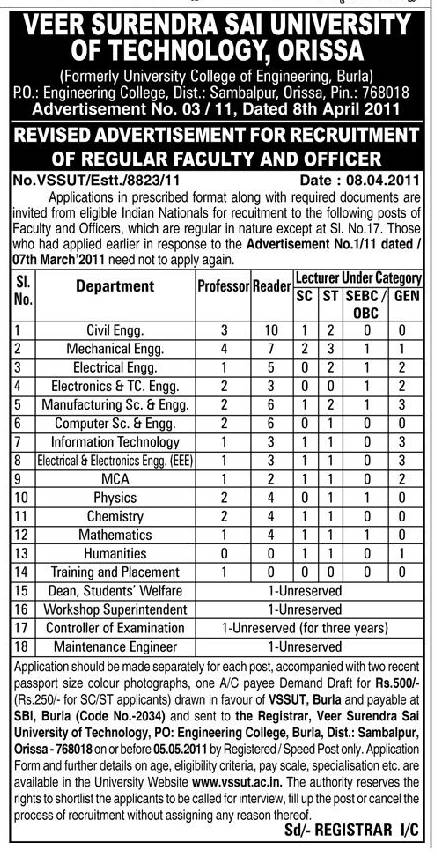
Following is from a mail sent by Prof. Rakesh Mohanty of VSSUT Burla. It also appears in the alumni site at http://vssut.org/uncategorized/history-created-by-honorable-vc-vssut-burla/.
You will be thrilled and suprised to know that under the dynamic leadership and painstaking effort of Honorable Vice-chancellor, VSSUT Burla, Govt of Orissa has sanctioned 96 New Regular faculty positions (Professors, Readers and Lecturers) for VSSUT Burla.
A great achievement for VSSUT Burla.
This is really wonderful news. If they are able to hire good people against these positions VSSUT will be one of the top technical university in the country and will be next in line for upgradation to an IIEST.
In 2006 the then UCE Burla had submitted a proposal for becoming an IIEST. At that time it had 97 positions sanctioned but with 62 faculty out of which 36 had Ph.D.
I am not sure of the current situation, but with 96 new positions, the sanctioned strength will at least become 193, which is a good number to make a claim for an IIEST.
As per a document prepared by the then UCE Burla in 2006, the then faculty strength of the colleges that were earlier shortlisted for becoming IIEST were as follows:
- IT BHU: 229 faculty with 170 having PhD
- UCET-Osmania U: 127 faculty with 57 having Ph.D
- BESU: 212 faculty with 136 having Ph.D
- UCE-Andhra U: 123 faculty with 68 having Ph.D
- CUSAT: 206 faculty with 151 having Ph.D
So VSSUT’s claim for an IIEST will now depend on how quickly and how many Ph.D faculty they can hire. The sanctioned strength of 193 is pretty good.
Note that earlier in March 2011 VSSUT had advertised for 34 positions (23 lecturers+ 9 readers + 2 professors). See http://www.vssut.ac.in/adv_20111.pdf.
April 9th, 2011
Next Posts
Previous Posts


